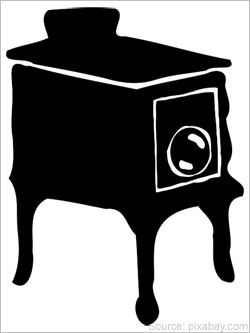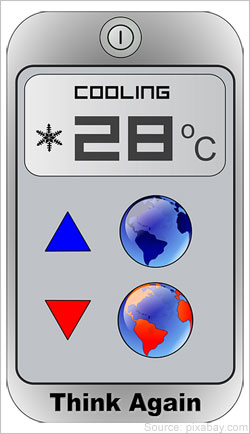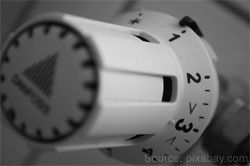There are a lot of costs associated with owning a house. The monthly mortgage payments that you have to make are only a fraction of the total monthly costs you'll be faced with when you own a home, and one of those costs is your gas and electricity bill. Sometimes these two costs are separate, depending on the gas and electricity companies that service your area, but often they will be combined into one cost, and high gas consumption can really drive up the monthly cost of your electric bill.

During the cold winter months, when you bundle up inside your house and crank up the heat to stay warm, you'll immediately notice a difference when you get your gas bill in the mail. If you're a new homeowner, seeing this figure for the first time can come as a real rude-awakening to just how much money you're spending to heat your home.
Your gas consumption isn't only limited to the winter though. The hot-water heater that you use to heat up your showers to the perfect temperature is also powered by gas and hot showers are great all-year-round, not just in the winter.
Luckily for many homeowners, there are tips and tricks that you can use to greatly reduce your household gas consumption and, in turn, lower your monthly gas bill. Some of these solutions are one-time adjustments that you can make to your home to reduce your gas consumption, and other tips are ways that you can alter your daily routine to make your gas consumption more manageable and your monthly gas bill more affordable.
Properly insulate your home
During the winter, cold air is constantly infiltrating your home through spots in your home that you didn't even realize were vulnerable to letting in cold drafts. Sometimes even the smallest cracks near a window or spaces beneath a door can let in a large amount of cold air that enters your home and goes to battle with your thermostat. While you continue to crank it up hoping to heat your home to a comfortable temperature so you can relax on the couch and watch TV, cold air is coming in like silently and unnoticed and undoing all of the efforts of your furnace. When it's all said and done, you end up spending more money to heat up your house.
Here is what you can do instead:
- Go around and check all of the doors and windows in your home to make sure that no cold air is getting inside through small cracks or openings. Older homes tend to have more problems with allowing cold air into the home than newer homes, which are usually freshly sealed and insulated, so if you have an older home you should be especially vigilant.
- Adding weather stripping around your windows and doors will greatly reduce the drafts of cold air coming in during the winter.

- Even placing curtains on your windows will go a long way in helping to keep your house warm so that you won't have to spend so much time (and money) cranking up your thermostat to avoid the chill.
- If your home is an older one, check your insulation and consider increasing the amount of insulation in areas of your house where cold air is more likely to enter, like the attic, the garage and the basement.
Check your furnace and water heater
Your household gas consumption can also be affected by the age and efficiency of your hot-water heater and furnace. Older, less efficient models will typically use gas at a higher rate, and it will greatly benefit your wallet and lessen your gas consumption if you upgrade to a newer, more efficient model. While this may set you back quite a bit in the short term, over the long run you will save much more money and it will be a worthwhile investment to make.
In addition, there are some other methods you can employ to check up on your hot-water heater and furnace and make sure that they are operating efficiently, and if you don't need to upgrade your units or can't afford to, there are other ways in which you can decrease your gas consumption and lower your monthly gas bills.
- Check all of your furnaces and have them tuned up and running at full efficiency.
- If you have forced-air furnaces, regularly change your filters and clean them periodically.
- Place insulation around your hot-water heater. This will increase its efficiency and also minimize the amount of gas it is forced to use throughout the course of the year.
By following a few simple steps to ensure that your home is properly insulated and that your hot-water heater and furnaces are running at maximum efficiency, you can go a long way in cutting your year-round gas consumption and lowering your monthly gas bills. Remember, the harder your furnaces and water heater have to work to heat up your home and your water, the more gas you are going to be using and the higher your bills are going to be, so it's all about maintaining and efficiency and keeping all of the cold air locked out of the house and kept outside where it belongs.
Controlling the thermostat
One of the best ways to cut down on your gas consumption and lower your gas bills is by regulating your thermostat during the winter months. Many experts agree that the optimal living temperature to set your thermostat at during the winter is between 67 and 69 degrees Fahrenheit, with most people falling in the middle at 68 degrees. This temperature is perfect for maintaining a comfortable in-home climate during the winter, and if you can maintain a steady temperature of 68 degrees, you'll likely keep your gas bills down.

Of course, smaller homes heat up more quickly than larger homes, so the size of your living space comes into play when you're talking about heating your home. However, if you can deal with wearing a sweatshirt or sweatpants around the house and using blankets, you can keep your thermostat low and really cut down on your gas consumption.
For example, when you go to bed at night, turning your thermostat down to 64 or 65 degrees will really make a big difference in the amount of gas you use on a monthly basis. The same goes for when you leave the house for the day to go out to work - turning the thermostat down anywhere from 8 to 10 degrees can really go a long way. While it doesn't seem like a difference of a few degrees will have that great of an impact, it truly does.
Here are some other tips to help you cut back on your gas consumption throughout the year:
- Install some ceiling fans to keep the air in your home circulating
- Install low-flow showerheads that will help limit the use of the hot-water heater
- Seal up any unused fireplaces to prevent any cold air from entering your house through the flues.